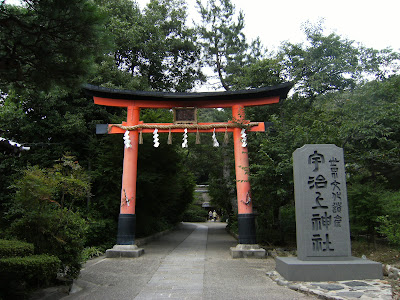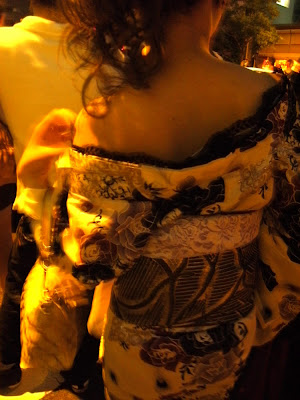The Miho Museum is a joint Japanese and American project completed by the architect, Dr. I. M. Pei and Kibowkan International, Inc. in August of 1996 on a scenic mountainside in a nature preserve near the center of the town of Shigaraki, Shiga prefecture, Japan.
Official website of Miho Museum :http://www.miho.or.jp/english/index.htm
Posted by Akiko at http://teaceremonyen.com/
August 13, 2011
August 8, 2011
NARA TO-KAE in Nara
Nara To-kae is light festival in early August festival in Nara since 1999.
About 20,000 candles light up at some Heritage sites.
Posted by staff at http://www.yado-web.com/
About 20,000 candles light up at some Heritage sites.
Posted by staff at http://www.yado-web.com/
August 1, 2011
A Thousand Years of History at World Heritage Byodoin temple in Uji city in Kyoto
Byodoin temple was established by Kampaku (chief advisor to the Emperor) Fujiwara Yorimichi in 1052.
Phoenix Hall was constructed the following year 1053 as the Amitabha Hall (national treasure) to enshrine a statue of Amitabha Tathagata (also national treasure).
The garden, a Pure Land borrowed landscape garden, has been designated a historic site and a place of scenic beauty.
The Suhama(sandy beach),the Hirabashi(flat bridge), the Soribashi(arched bridge) and the Kojima(small island) surround Phoenix Hall.
Byodoin houses numerous cultural assets from the Heian Period: Yamato-e style paintings depiciting Amida's nine grades of descnet, the Buddhist Temple-Bell, and the pair of Phoenixes-all national treasures.
Particularly outstanding are the 52 statues of Worshiping Bodhisattvas on Clouds. These delicately carved national treasures, the only existing group of Buddhist statues from the 11th century, ride on clouds while dancing or playing various musical instruments.
Byodoin is one of the few examples of Heian temple architecture left in Japan.
The most famous building in this temple is the Phoenix Hall.
Phoenix hall, modeled after the palace in the Land of Happiness, features unique architecture.
It has three wings, creating an image of the mythical bird of China,
The central hall is flanked by twin wing corridors on both sides, with a tail corridor.
Phoenix Hall inside tour is available by extra charge 300 yen.
Inside, there is a colletction of Pure Land Buddhism sect art from the Heian Period,
including a seated stature of Amitabha Tathagata, the only existing Buddhist image
confirmed to have been made by Jocho, a sculptor representative of the Heian Period.
Tour is about 10-15 minutes.
Please be aware Phoenix Hall is National Treasure.
Staff advise me to store my large bags to the coin locker, which locate at the gate.
We should pay attention not touch the pillars doors paintings or other parts of the structure.
Large bags and umbrella will not be allowed to bring inside with us.
We can enter Hoshokan museum, which opened in 2001.
It exhibits various treasures from Byodoin, including a Buddhist Temple-Bell, the pair of
Phoenixes and the 26 statues of Worshiping Bodhisattvas on Clouds.
the museum also uses computer graphics to provide virtual exhibitions and is equipped with a reference system that allows convenient access to ultra-high-resolution images of Phoenix Hall
Admission : 600 yen
Hours: Daily 8:30am to 5:30pm ( Ticket office close at 5:15pm)
Access :10 minutes walk from JR Uji Station.
10 minutes walk from Keihan Line Uji Station.
Do not miss this National Treasure and a World Heritage Site to visit!
Posted by staff at http://www.yado-web.com/
Entrance
Kannondo
Beautiful flowers will be in bloom in early May.
Phoenix Hall
The Hoshokan museum.
Byodoin's temple bell
Ujigami Shrine locate near Byodoin, and this shrine is also registered as a World Heritage Site.
Ujigami Shrine was found via dendrochronology to be the oldest original Shinto shrine in Japan
having been built around 1060, and is supposed to have a close relation with Byodoin in 1052.
Uji city is also famous for tea. You will find some tea shops nearby.
Uji River
Phoenix Hall was constructed the following year 1053 as the Amitabha Hall (national treasure) to enshrine a statue of Amitabha Tathagata (also national treasure).
The garden, a Pure Land borrowed landscape garden, has been designated a historic site and a place of scenic beauty.
The Suhama(sandy beach),the Hirabashi(flat bridge), the Soribashi(arched bridge) and the Kojima(small island) surround Phoenix Hall.
Byodoin houses numerous cultural assets from the Heian Period: Yamato-e style paintings depiciting Amida's nine grades of descnet, the Buddhist Temple-Bell, and the pair of Phoenixes-all national treasures.
Particularly outstanding are the 52 statues of Worshiping Bodhisattvas on Clouds. These delicately carved national treasures, the only existing group of Buddhist statues from the 11th century, ride on clouds while dancing or playing various musical instruments.
Byodoin is one of the few examples of Heian temple architecture left in Japan.
The most famous building in this temple is the Phoenix Hall.
Phoenix hall, modeled after the palace in the Land of Happiness, features unique architecture.
It has three wings, creating an image of the mythical bird of China,
The central hall is flanked by twin wing corridors on both sides, with a tail corridor.
Phoenix Hall inside tour is available by extra charge 300 yen.
Inside, there is a colletction of Pure Land Buddhism sect art from the Heian Period,
including a seated stature of Amitabha Tathagata, the only existing Buddhist image
confirmed to have been made by Jocho, a sculptor representative of the Heian Period.
Tour is about 10-15 minutes.
Please be aware Phoenix Hall is National Treasure.
Staff advise me to store my large bags to the coin locker, which locate at the gate.
We should pay attention not touch the pillars doors paintings or other parts of the structure.
Large bags and umbrella will not be allowed to bring inside with us.
We can enter Hoshokan museum, which opened in 2001.
It exhibits various treasures from Byodoin, including a Buddhist Temple-Bell, the pair of
Phoenixes and the 26 statues of Worshiping Bodhisattvas on Clouds.
the museum also uses computer graphics to provide virtual exhibitions and is equipped with a reference system that allows convenient access to ultra-high-resolution images of Phoenix Hall
Admission : 600 yen
Hours: Daily 8:30am to 5:30pm ( Ticket office close at 5:15pm)
Access :10 minutes walk from JR Uji Station.
10 minutes walk from Keihan Line Uji Station.
Do not miss this National Treasure and a World Heritage Site to visit!
Posted by staff at http://www.yado-web.com/
Entrance
Kannondo
Beautiful flowers will be in bloom in early May.
Phoenix Hall
The Hoshokan museum.
Byodoin's temple bell
Ujigami Shrine locate near Byodoin, and this shrine is also registered as a World Heritage Site.
Ujigami Shrine was found via dendrochronology to be the oldest original Shinto shrine in Japan
having been built around 1060, and is supposed to have a close relation with Byodoin in 1052.
Uji city is also famous for tea. You will find some tea shops nearby.
Uji River
July 25, 2011
July 17, 2011
Kibune (Kifune ) is relaxing and cool place to visit for summer in Kyoto
Kibune is one of resort place in Kyoto especially summer and autumn.
People would like to escape from high humidity levels in Kyoto city in summer and
enjoy to see red leaves in autumn.
Kibune is about 30 minutes by train up to the north mountains and people say that
Kibune village is about 5-10 centigrade degrees cooler than downtown.
Not only these reasons, there are some valuable attractions to visit here.
River restaurants which are located right above the cool river is very unique style dining.
These restaurant are well know as wonderful meal of river fish and other delicacies
while sitting atop of river surrounding by the beauty of nature.
Though evening meals can be quite expensieve but lunches are reasonable priced.
The other attraction is Kifune-jinja Shrine
Kifune-jinja Shrine is one of the oldest Shinto shrines in Kyoto and home to the God of Rain.
After a great flood had done much damage to the capital, this shrine have been in use for
centuries as a place to ask the rain to either halt the rains or bring on the rain.
Over the history, this shrine often did a ritual for rain.
Kifune-jinja Shrine is also famous for the benefit for love.
Izumi Shikibu, a female poet in the 10th – 11th century composed a haunting and
poem here and prayed to regain the love of her husband.
Today, many visitors come to pray for love.
Not only these attractions, you might feel mystic and rustic atmosphere here old shrine.
Two giant ceders, 600 and 700 year old welcomes us at the entrance and
we see statues of horses by the building
We might to try water fortune telling attracts.
We buy a sheet of paper and put it on the spring on the site.
Letters emerge and tell our fortune.
Admission free.
Eizan railway takes you to Kibune in about 30 minutes from Demachiyanagi station.
staff at http://www.yado-web.com/ will check timetable.
Please ask staff freely.
River restaurants.
Kifune-jinja Shrine
Giant ceders.
People would like to escape from high humidity levels in Kyoto city in summer and
enjoy to see red leaves in autumn.
Kibune is about 30 minutes by train up to the north mountains and people say that
Kibune village is about 5-10 centigrade degrees cooler than downtown.
Not only these reasons, there are some valuable attractions to visit here.
River restaurants which are located right above the cool river is very unique style dining.
These restaurant are well know as wonderful meal of river fish and other delicacies
while sitting atop of river surrounding by the beauty of nature.
Though evening meals can be quite expensieve but lunches are reasonable priced.
The other attraction is Kifune-jinja Shrine
Kifune-jinja Shrine is one of the oldest Shinto shrines in Kyoto and home to the God of Rain.
After a great flood had done much damage to the capital, this shrine have been in use for
centuries as a place to ask the rain to either halt the rains or bring on the rain.
Over the history, this shrine often did a ritual for rain.
Kifune-jinja Shrine is also famous for the benefit for love.
Izumi Shikibu, a female poet in the 10th – 11th century composed a haunting and
poem here and prayed to regain the love of her husband.
Today, many visitors come to pray for love.
Not only these attractions, you might feel mystic and rustic atmosphere here old shrine.
Two giant ceders, 600 and 700 year old welcomes us at the entrance and
we see statues of horses by the building
We might to try water fortune telling attracts.
We buy a sheet of paper and put it on the spring on the site.
Letters emerge and tell our fortune.
Admission free.
Eizan railway takes you to Kibune in about 30 minutes from Demachiyanagi station.
staff at http://www.yado-web.com/ will check timetable.
Please ask staff freely.
River restaurants.
Kifune-jinja Shrine
Giant ceders.
Subscribe to:
Posts (Atom)



















































